The essayistic film Milisuthando is meditative and slow — it presents long, romantic shots where the camera is simply moving from scene to scene, punctuated with poetic narrations, often layered over resonant polyphonic melodies.
The shots are evocative, meandering and mesmerising — a small flame travelling slowly through space from stick to candle, large expanses of land foregrounding huts and cows, and planes skywriting against the backdrop of positively clear blue skies. We’re drawn in, called to look closely and through this process are able to produce new insights into what we see. A new South Africa or a new, new South Africa is being formulated. Nostalgia is at play.

In an anonymous anarchist text, At Daggers Drawn republished many times on the internet, the writers note;
The only way to learn what freedom is, is to experiment with it.
And to do so you must have the necessary time and space.
The fundamental premise for free action is dialogue.
[And] Any authentic discourse requires two conditions:
- a) a real interest in the questions brought up to be discussed (the problem of content) and
- b) the free search for possible answers (the problem of method).
These should happen at the same time given that the content determines the method and vice versa.
Let’s begin with content…
The feature-length documentary film, Milisuthando, takes the personal essay format to tell the story of what it means to be human in the context of race. Combining elements of historical account, and personal experiences, the work is at once observational and performative. The film carries the name of its maker — the bearer of love where there is none. The name is significant, it weighs a great deal. It brings to the fore the question of what love is and its place in political struggle. Because surely a film about race is necessarily a film about political struggle and political struggle is necessarily about freedom and liberation. Bongela explores these ideas in five chapters — from birth (imbeleko) to death (ibhokwe ikhalile ekhaya ).
The writer and director of the film, Bongela is known primarily for her writing, which appeared in the Mail and Guardian, City Press, W Magazine, Dazed and Confused, Aperture Magazine, Elle and Colours among others. In this work she seeks to explore the post-apartheid condition in South African society, focusing on the psychological effects of racism on black South Africans.
In the film, we see Bongela in critical conversation with her white friends – one of whom is the producer of the film Marion Isaacs. Isaacs understands Bongela and sees her (really sees her) we are told.
My first and main critique of the work is its failure to read whiteness as a construction deeply embedded in normalised systems of privilege. Bongela seems to frame dialogue (in the context of interpersonal relationships) as a crucial component within the discourse of race. This is not wrong, of course, but as the aforementioned anarchists warn us – free action is the premise of real dialogue. Here, free can be read as unconstrained, unbounded, at liberty, and emancipated. I want to argue that regardless of how free a subject considers themselves to be, that sense of freedom is questionable if it does not have real material effects (as a unit, Black people do not have the kind of economic freedom that would render them truly emancipated).
Of course, the impulse to reflect on race through intimate encounters is not new. Just this year alone I can point to a few theatre productions staged in Cape Town where the narrative spine is constructed around people of different races thrust together to navigate the complexity of race and life — and always real love conquers all. It’s Isabel Dyson and Thami Mbikwana in Athol Fugard’s My Children My Africa. It’s Amelia and Andile in Joanna Evans’ The Year of The Bicycle. It’s Jack Morris and Lunga Kunene in John Kani’s Kunene and the King. Each of these works details the difficult tensions that exist in interpersonal relationships between people of different races (and sometimes class and gender too). I argue that centring the personal over the systematic can overly rely on sentimentalism in damaging ways. In this sense, sentimentality becomes a trope, as if we can imagine these gestures as a kind of restitution for past crimes.
In the paper, The Context of Race/Ethnicity in Interpersonal Relationships: Crossing the Chasm, Terri L Orbuch and Mark A Fine write that “despite important strides and progress, literature on interpersonal relationships continues to be quite limited in the context of race and ethnicity”.
They argue further that:
“Even though the concept of race may have little biological support (i.e., there are few, if any, clear-cut biological distinctions or markers of traditional racial categories), the concept of race/ethnicity has important psychological and social meaning. Thus, rather than abandoning and ignoring the concept, we argue that we need to conceptualize race and ethnicity in ways that are responsive to the meanings that are attached to these concepts. Because these meanings are both social (i.e., how people in general view the concept of race) and psychological (i.e., individuals’ sense of their own race and ethnicity), both of these sets of meanings need to be included in the conceptualization of race and ethnicity.”
When we interrogate the workings of interracial relationships, we are not questioning their authenticity or their ability to function. Personally, I’m not interested in what my relationships with my white friends mean for Black liberation. As far as I’m concerned, my relationships with my white friends are the last thing on my mind when I think about ways of experimenting with freedom. I don’t and never have questioned whether or not white people are human and yet, because of the structures that whiteness has created and continues to uphold, my humanness continues to be a question to people who live in white bodies.
In chapter five of the film, artist and friend to filmmaker Bettina Malcomess reflects on an experience with her family helper — a woman she tells us is named Violet. After leaving the employ of the family, Violet encounters Bettina in the street and “looks through her” – as if she does not know or see her. This is painful for Bettina, so painful that she cries! Reflecting on this scene in particular, I am shocked at Bettina’s shock and shocked further by her tears. To me, Malcomess’s tears only highlight the profundity of the chasm between white subjects and Black pain. This woman (maybe her name is Violet) who would have been subjected to degrading conditions (even in “nice white households”) through the violent and oppressive system of apartheid, shocks the daughter of her employer when she chooses (if she did in fact choose) to not engage them (perhaps not even knowing how to) years after leaving unrewarding employment (under undisclosed circumstances.) I argue that this lack of recognition of pain courses through and remains unacknowledged in large and small ways in the film. Bongela’s Black friends, invited to speak on their experiences within Model C schools as children, are not given the same time or space. We do not hear their voices at length. They do sing though! What might be passed off as inconsequential — singing but not speaking at length, is actually a deeply painful and problematic moment that I want the makers of the film and all of us to take seriously. I argue, taking instruction from Wynter, that the counter to racial oppression is not in fact intimacy with our white friends but rather giving centrality to people who are continually oppressed in a hegemonic, largely secular, pseudo-liberal and anti-black system. And of course, you’re probably thinking that these are not diametrically opposed, and you’re right. Both And! I’m interested in having more conversations that centre many different kinds of Blackness, not always in relation to whiteness ( which often is codified in white bodies).

In the film, we are introduced to Bongela’s grandmother, u’Makhulu. Makhulu whose wonderful and life-affirming relationship with Bongela is in many ways central to the first half of the film. Her reflections and memories of the old Transkei weave together immerse complexity and hold the tenderness that is at the heart of what it means to speak of love, joy and heritage. Through interactions with her, the story of the Republic of Transkei, an unrecognised state between 1976 to 1994 is taken from a purely abstract historical detail to a lived and embodied experience.

Now let’s talk about method….
On the 28th of July 2014, an unnamed woman is caught naked on camera in front of the Madiba statue at the Nelson Mandela square in Sandton. Probing male voices are overheard — they remark, they laugh — through the shaky footage. The woman seems calm, reflective but also possibly distressed. A few minutes later she puts her clothes back on and walks away with very little drama. Because the film begins with the naked woman in front of the Madiba statue, I read this as a moment of nakedness as protest. Bordo and Cover write that nakedness is filled with multiple, context-bound, historically-specific meanings. It can be a pleasurable experience, a mundane activity, or a humiliating event depending on the situation, on who is shedding the clothes, whether there is a spectator, and in that case, on the spectator‘s relationship to the naked person. Naked protest dramatically enacts protesters‘ willingness to put their bodies on the line to advance a political cause. This opening scene, promises a dialectic between power and vulnerability, that I believe is not then adequately addressed. If we think of that protesting woman in front of the Madiba statue, then we might want to complicate the legacy of Mandela in both nuanced and obvious ways. Why is it then that the figure of Madiba is not complicated in the rest of the film? Instead, he is depicted (perhaps with some irony that I was not able to detect) as a loving (grand)father who preaches reconciliation through love. And of course, this is precisely what he did. But his story is also a complex one. It’s a story of disappointment. A story of the limits of love and what he described as forgiveness.
The film is not just a personal account as it attempts to contribute to a conversation on race relations. And so I’m left to wonder what political ideologies exactly underpin this work — frame its research, its questions and its method. And how do we know that it was successful in reaching these goals?
Although I congratulate Bongela on the work of starting, because as Aristotle wrote: “It is by doing things that need to be learned in order to do be done that you learn them” I have to be critical and place a large responsibility on anyone who has the power (large or small) to shape the discourse on race in South Africa (potentially elsewhere). In light of the move towards fascism, police brutality and the catastrophic yet normalised black death, I have to ask more from the images I see and from the work that I consume.
In the context of this film, I want to step back and seriously consider the workings of a love ethic (which is implied in the work). bell hooks wrote that there can be no love without justice. She wrote that care and affirmation, the opposite of abuse and humiliation, are the foundation of love. Until Black people are cared for and affirmed and have real justice and real freedom, there can be no love.



















































